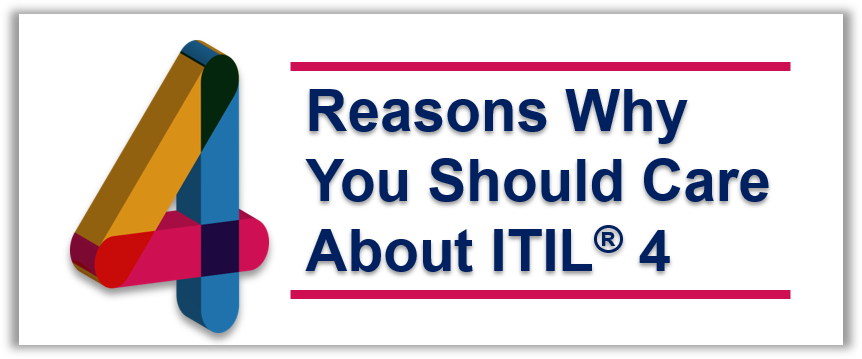By Doug Tedder

The latest edition of ITIL, ITIL 4, was released in February 2019 with the distribution of the ITIL Foundation ITIL 4 Edition book. Coming in at just over 200 pages, there is a lot that is familiar, yet new, when compared with previous editions of ITIL. Although the Foundation book is only the first of six volumes that discuss the ITIL 4 guidance, there are many reasons why you should care about ITIL 4. Here are my top four:
ITSM is Not Just About IT
Fact is, service management was never just about IT, although many organizations approached it that way.
That’s the idea behind the ITIL 4 concept of ‘value co-creation’, where both the service provider (whether that is IT or another part of the organization) and the customer (whoever that is) both have responsibility for the creation of value.
Looking at this from an IT perspective, much of what IT is (should be) doing are actually business decisions. The 34 practices described in ITIL 4 highlight this, by identifying 14 “general management” practices. These general management practices include things like risk management, organizational change management, continual improvement, supplier management, and more. Think about it. In most organizations, IT doesn’t make purchases; the procurement team does. IT doesn’t determine the risk appetite and approach for the business; it’s the other way around. And if it’s only IT that deals with organizational change management, then how will business transformation ever be successful?
“Change Control”, not “Change Management” …for a Good Reason!
With the introduction of the Change Control practice, the emphasis with managing changes shifts from ‘control’ to ‘enablement’ (although I find it ironic that the authors chose to call this practice “Change Control” rather than “Change Enablement”). The purpose of Change Control is to maximize the number of successful service and product changes.
One of the ways that Change Control maximizes the number of successful changes is through the use of a change authority. A change authority is a person or group that (wait for it) authorizes change. But think about it – this could be literally anyone – the organization just has to define who has the authority to approve what changes.
While ITIL V3 did discuss a “change authority”, most organizations wrongly funneled every change through a CAB (Change Advisory Board) as the (only) change authority – essentially grinding execution of changes to a slow crawl. In most cases, this approach actually minimized the number of successful changes. But in today’s always on, always connected world, having a single body review and approve changes is impossible – nor will it meet the business need.
The Guiding Principles are a Beautiful Thing
I’ve long said that one of the things that effective service management means is that there is more than one “tool” in the service management “toolbox”. Depending on the situation, other approaches such as DevOps or Lean (as well as ITIL) may be needed to meet a business need.
How can an organization ensure that the variety of approaches work together in harmony? That’s where the Guiding Principles come in. I talked about the Guiding Principles in a previous post, but it is worth mentioning again. Use of and following the Guiding Principles are key in integrating ITIL with other bodies of knowledge, methodologies and standards.
Even if your organization only wants to leverage ITIL, the Guiding Principles provide outstanding guidance and clarity for how to approach ITSM implementation.
Shift from a Lifecycle-Based Approach to a Value-Based Approach
While ITIL V3 discussed value delivery in the form of services, many organizations got lost in the lifecycle and processes concepts. They missed (or overlooked) the idea that it was services that delivered the real value that an organization required. With ITIL 4, the Service Value System introduces a “systems thinking” approach for the co-creation of value and provides a structure for success for service management.